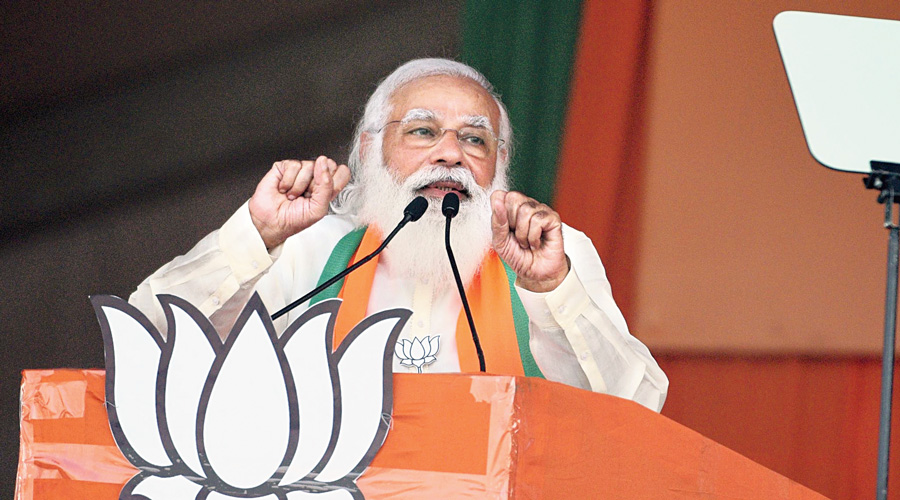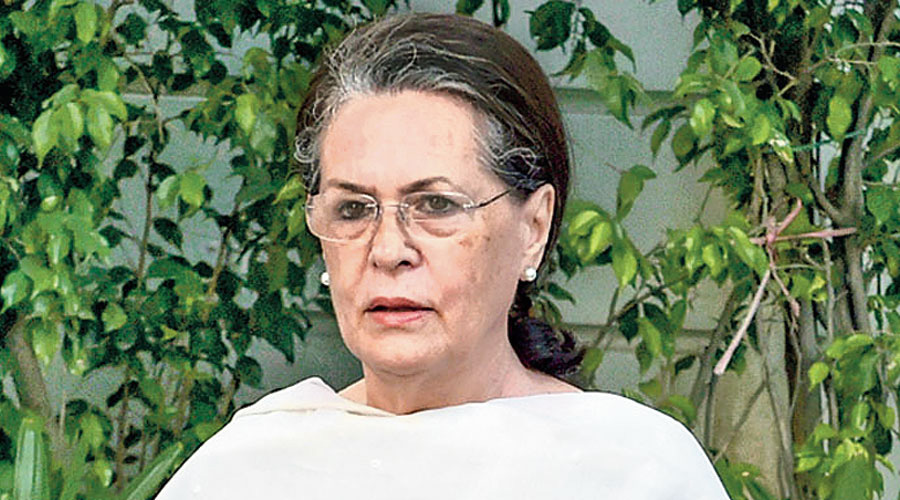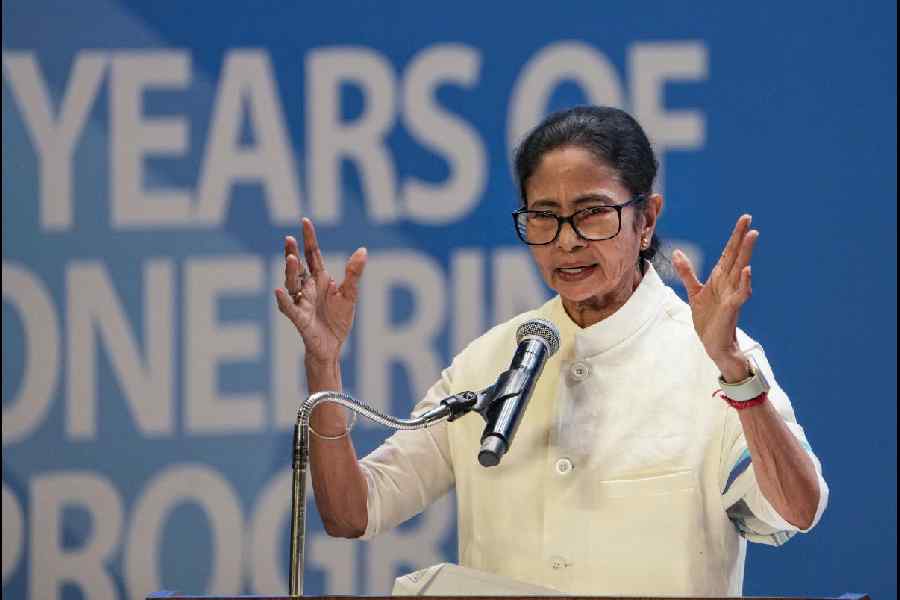Prime Minister Narendra Modi on Sunday delivered an address that was long on duration but short on the face and formula that will drive his mission to conquer Bengal.
Modi touched on a wide array of issues in his address that went on for 1 hour and 10 minutes, making it probably his longest speech in Bengal in recent memory.
The setting was perfect for the Prime Minister to build a focused narrative that has become his hallmark — the crowd count under the roasting March sun was put at 20 lakh by the BJP and 4 lakh by police sources — but he chose to trapeze from one issue to another.
Modi appeared to have been moved by the turnout on the Brigade Parade Grounds, a sprawling stretch that intimidates crowd gatherers.
“In my long political life, I have addressed many rallies but I have never been blessed by such a huge turnout,” the Prime Minister said at the outset, much to the delight of the state BJP team that had left no stone unturned to ensure a high turnout.
The takeaways from Modi’s 70-minute address:
PM or local leader?
Modi was oblivious to the gravitas of his chair or deliberately overlooked it because the event was political.
The speech did give the impression that the Prime Minister of India had reduced himself to a state-level leader busy attacking the incumbent in his desperation to win an Assembly election.
“In the past 10 years, has the TMC brought any change to the life of an ordinary family in Bengal? Has there been any change in the life of a farmer or a worker?” he asked. “Haven’t the poor become poorer in Bengal under the TMC?”
The questions are pertinent but the same questions can be asked of most of the states and the central government as well.
While Modi worried about “an ordinary family in Bengal”, he sidestepped the most immediate issue affecting every family in the country.
He made no mention of the inexplicable rise in fuel prices although he went out of his way to mock Mamata Banerjee for riding a two-wheeler recently to highlight the plight of the common people.
Modi’s expression of concern for the farmers and the workers too sounded a bit rich, considering thousands of farmers have been squatting on highways near the capital for over 100 days and several farmers have died.
For the workers, the biggest nightmares of late have been the ill-managed lockdown that hit livelihoods and the use of the pandemic as an excuse to push through changes in labour rules.
If the words “Bengal” and “TMC” are replaced with the names of any other state and ruling party — even BJP-ruled states — Modi’s questions cannot be wished away.
Not just the Opposition parties, even eminent economists have been demanding answers to such questions from the BJP-led government at the Centre.
Modi cannot be faulted for prodding Bengal towards “asol poriborton (real change)”. But for the sake of credibility, the Prime Minister is also expected to explain what real change his seven-year rule has brought about in the country, whose economy shrank the most among the developing countries during the pandemic.
There was no sharing of details on another top-of-the-mind issue: the goal of vaccinating all Indians.
Modi, however, didn’t forget to check the allegations boxes — like Mamata’s love for her nephew, appeasement politics and the syndicate raj in Bengal. But these issues have been mentioned by the state leaders of his party.
As the state leaders — such as Bengal BJP president Dilip Ghosh and Trinamul turncoats like Mukul Roy and Suvendu Adhikari — got relegated to Modi’s cheerleaders, the Prime Minister took on their mantle by attacking Trinamul and making the polls appear a Modi-versus-Mamata duel.
In doing so, the Prime Minister exposed one of the biggest deficiencies of the Bengal BJP — the absence of a credible face to take on Mamata.
In search of a formula
Modi repeatedly stressed that the BJP believed in delivering on its promises, and presented a development-oriented agenda.
“The BJP not only makes promises, it also delivers…. Whatever we say, we implement it in a time-bound manner,” the Prime Minister said.
The statement may not be appreciated by lakhs of Matuas — Hindu immigrants from Bangladesh who had voted wholeheartedly for the BJP in the Lok Sabha polls after Modi promised at a rally that his government would implement the CAA to offer citizenship to them.
More than 16 months have passed since the new law came into effect but the CAA rules are yet to be implemented.
On Sunday, Modi was silent on the new citizenship matrix, which was a key theme ahead of the Lok Sabha polls.
In an attempt to shed the outsider tag, Modi spoke about the party’s “DNA link” with Bengal courtesy Syama Prasad Mookerjee, founder of the Jana Sangh.
The formal welcoming of actor Mithun Chakraborty, 70, to the saffron camp too was aimed at establishing the party’s Bengal connect. Some unkind social media trolls did not miss the chance to wisecrack: “Wanted Dada, got dadu,” referring to speculation that the BJP was keen to induct Sourav Ganguly, who did not attend the Brigade event.
Then came a flurry of development promises as he spoke about pucca homes for slum dwellers, new flyovers in Calcutta, engineering and medical education in the local language and an overhaul of the administrative delivery system in the state. He proposed Bengal’s industrial rejuvenation through ports and food processing industries.
The attempt to cover so many issues gave the impression that the saffron camp had realised that finding one magic formula to woo the voter is difficult in a diverse and heterogeneous Bengal.
Promise of real change
Modi spun a loosely stitched “asol poriborton (real change)” canvas that will take shape once the BJP comes to power.
“Those who have come here have come with the hope of asol poriborton. And I have come here to give you the confidence that real change will take place, Bengal will prosper and develop, and the situation will change as investments will come and industry will grow,” Modi said.
“We will create a Bengal where youths will get education and employment, whose people won’t have to migrate in search of jobs, where industry will flourish and investments will flow in…. It will be a Bengal that will have the best of 21st-century infrastructure.”
Sounds like the promises made during the “achchhe din” campaign of 2014? No one touches the phrase “achchhe din” now with a bargepole.
Another elephant in the Brigade room that was not acknowledged: if the BJP wins, how will it bring about the promised changes with several Trinamul faces having crossed over to the saffron stable?











